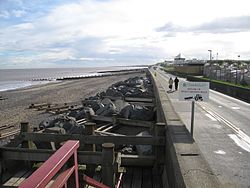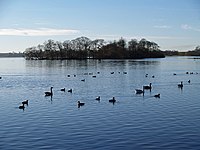Hornsea
| Hornsea | |
| Yorkshire East Riding | |
|---|---|
 Hornsea coast | |
| Location | |
| Grid reference: | TA203476 |
| Location: | 53°54’39"N, 0°10’3"W |
| Data | |
| Population: | 8,243 (2001) |
| Post town: | Hornsea |
| Postcode: | HU18 |
| Dialling code: | 01964 |
| Local Government | |
| Council: | East Riding of Yorkshire |
| Parliamentary constituency: |
Beverley and Holderness |
Hornsea is a small seaside resort town in the East Riding of Yorkshire. Just like the larger resorts in the area, such as Withernsea, Bridlington, Filey and Scarborough, the town has a promenade with shops selling fish and chips, ice cream, bucket and spade sets and other traditional seaside paraphernalia.
For more vigorous vistors, Horsea also stands at the eastern end of the Trans Pennine Trail.
Hornsea is well known for pottery. The factory, Hornsea Pottery, closed in 2000, but the largest display of Hornsea Pottery in the world can be seen at the Hornsea Museum. Opposite stands 'Bettison's Folly', a tower built by a local businessman in the 19th century.
Town and coast
Hornsea has many coastal defences such as sea walls, groynes and beach nourishment. Despite these defences, Hornsea's primarily cliff-based shoreline is eroding at one of the fastest-known rates in Europe.[1] Coastal erosion is very bad at either end of the main esplanade.
Hornsea Mere, a large lake and bird sanctuary, lies near the town and is popular for sailing. Hornsea Mere is a natural lake (not one of the manmade boating lakes one sees about) which was created by glacial movement during the Ice Age.

From 1864 to 1964 Hornsea had two railway stations, Hornsea Bridge and Hornsea Town, on the Hull and Hornsea Railway which connected it to Hull. The line was opened by Joseph Armitage Wade, whose house once stood where Hornsea School and Language College stands today.
A cottage close to the school was once visited regularly by Lawrence of Arabia. Winston Churchill visited, and was photographed in, another house nearby. Other famous visitors to the town include Charlotte Brontë.[2]
After the railway was recommended for closure by Dr Richard Beeching, the trackbed became the final lap of the Trans Pennine Trail. The old railway line is now a well-maintained walking and cycling (bicycles only) trail. It is a very pleasant trail with appropriate stopping points for picnic lunches.
Sport
- Cricket: Hornsea Cricket Club play at the Hollis Recreation Ground, just off Atwick Road
- Rugby: Hornsea RUFC play at the Hollis Recreation Ground and are nicknamed the 'Hollismen'
Outside links
| ("Wikimedia Commons" has material about Hornsea) |
- Hornsea Golf Club | Yorkshire Golf Course
- Hornsea Town Council
- Hornsea Scouts
- Hornsea Museum
- Hornsea Sailing Club
References
- ↑ "Erosion and Flooding in the Parish of Hornsea - Coastal Erosion". The East Yorkshire Coastal Observatory. http://www.hull.ac.uk/coastalobs/hornsea/erosionandflooding/index.html. Retrieved 3 February 2008.
- ↑ Gaskell, Elizabeth Claghorn. The Life of Charlotte Brontë, Volume 2, chapter 29.
- Gazetteer — A–Z of Towns Villages and Hamlets. East Riding of Yorkshire Council. 2006. p. 7.
Further information
- A Brief History of Hornsea www.hornsea.gov.uk (Hornsea Town Council)
